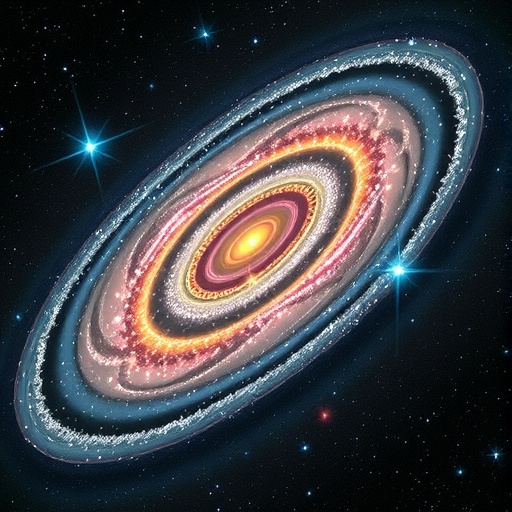Astronomers have recently unearthed momentous findings regarding the formation of galaxies in the early universe, utilizing the unparalleled observational capabilities of the James Webb Space Telescope (JWST). This monumental study, executed by a highly skilled team from the University of Cambridge, evaluated over 250 young galaxies stemming from a time period only a few hundred million years following the Big Bang. Their research signifies an exciting leap forward in our understanding of cosmic evolution, particularly regarding how early galaxies differed significantly from the more orderly structures we observe today.
As the universe transitioned from its initial chaotic states, researchers discovered that many of these young galaxies were not the sleek, well-ordered structures we see in modern times. Instead, they exhibited a chaotic configuration characterized by turbulence and disarray. This revelation stems from the detailed analysis of gas movements within these galaxies, which was made possible via JWST’s NIRCam instrument deployed in a specialized filming mode known as ‘grism mode’. By capturing the faintest light emitted from ionized hydrogen gas, the team was able to reveal the intricate gas dynamics that escape traditional observation methods.
In analyzing these early galaxies, researchers noted a marked variance in behavior. While some of the galaxies began forming ordered rotations indicative of developmental maturity, the overwhelming majority remained chaotic and complex. The gas in these turbulent galaxies was found to be in constant motion, puffed up and converging from multiple directions rather than settling into the smooth stratification we see in contemporary spiral galaxies. This turbulence is attributed to the star formation processes and gravitational instabilities that prevailed at that time, creating a rich yet chaotic environment.
The collaborative efforts of the research team, spearheaded by first author Lola Danhaive, allowed for the unprecedented observation of these galaxies as entire populations rather than isolated instances. Danhaive expressed the importance of this comprehensive viewpoint, stating, “We found huge variation: some galaxies are beginning to settle into ordered rotation, but most are still chaotic.” This innovative insight proves instrumental in painting broader strokes of how galaxies mature over cosmic time, facilitating a deeper grasp of the transition from chaos to order in galactic structures.
Co-author Dr. Sandro Tacchella emphasized the implications of these results on pre-existing models of galaxy formation. “Previous results suggested massive, well-ordered disks forming very early on, which didn’t fit our models,” he remarked, presenting a significant contradiction to earlier assumptions in astrophysics. This trend underscores the shift from a singular or a couple of galaxy observations to analyzing hundreds of galaxies, yielding a perspective that aligns more accurately with theoretical expectations. The evidence indicates that early galaxies experienced profound turbulence and instability, growing through frequent mergers and explosive bursts of star formation, further contributing to the chaotic era of galactic evolution.
The findings contribute significantly to bridging the knowledge gap between epochs such as reionization and the onset of what’s referred to as “cosmic noon,” a crucial period when star formation reached its peak. The research elucidates how fundamental building blocks transitioned over time from chaotic, clumpy formations into structured entities, paving pathways towards the formation of galaxies like the Milky Way. Notably, the chaotic state of these early galaxies adds an essential chapter to our understanding of cosmic chronology, illustrating the intricate processes that govern galactic evolution.
Not only does this research illuminate historical aspects of galaxy formation, but it also highlights the necessity of utilizing advanced observational technology such as the JWST. This groundbreaking telescope has allowed scientists to delve deeper into galaxy dynamics at scales previously considered unattainable. Research initiatives moving forward plan to utilize JWST’s capabilities further to integrate findings of cold gas and dust within these early galaxies to elaborate on their formation processes. Such advancements will cultivate a richer narrative surrounding our universe’s origins and the evolutionary trajectories of its components.
Reflecting on the overall significance of their findings, Tacchella stated, “This is just the beginning.” The path ahead is promising, with the prospect of incorporating additional data to track how these turbulent early systems evolve, potentially transforming into the graceful spirals that dominate the current cosmic landscape. This pioneering work not only reshapes our understanding of cosmic history but also sets the stage for ongoing inquiries that will ultimately deepen our understanding of galaxies’ formative years and their transition towards stability.
As science continues to unveil the vast complexities of the universe, studies such as this resonate profoundly amid the cosmic tapestry. They call upon researchers and enthusiasts alike to engage deeply with the unsolved mysteries of our cosmos. The impact of these endeavors extends beyond empirical discovery, compelling humanity to connect with its celestial origins and embrace the perpetual quest for knowledge that defines our exploration of the universe.
In summary, this study emphasizes the remarkable journey through which galaxies evolve from chaotic beginnings to more structured forms. The employment of cutting-edge technology like JWST underscores the essential role that modern astrophysics plays in unraveling the complexities of the universe. Each new discovery adds richness to our understanding of how the universe has shaped itself over billions of years, nurturing our quest and curiosity about the cosmos.
Subject of Research: Formation of early galaxies using JWST
Article Title: The dawn of disks: unveiling the turbulent ionised gas kinematics of the galaxy population at 𝑧 ∼ 4 − 6 with JWST/NIRCam grism spectroscopy
News Publication Date: 22-Oct-2025
Web References: DOI link
References: Monthly Notices of the Royal Astronomical Society
Image Credits: Credit: NASA, ESA, CSA, STScI, B. Robertson (UC Santa Cruz), B. Johnson (CfA), S. Tacchella (Cambridge), P. Cargile (CfA)
Keywords
Galaxy formation, James Webb Space Telescope, turbulent gas dynamics, early universe, cosmic evolution




